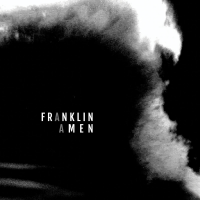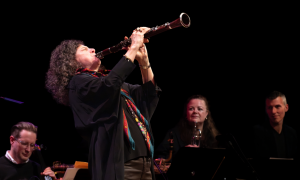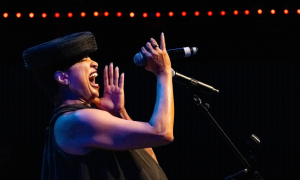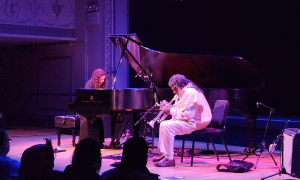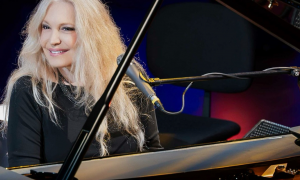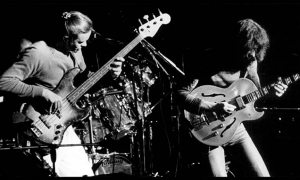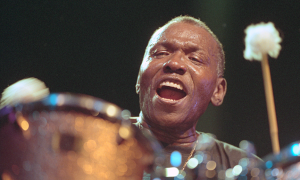Home » Jazz Articles » Live Review » Joe Doubleday Quartet At The Jazz Corner
Joe Doubleday Quartet At The Jazz Corner

The Jazz Corner
Hilton Head Island, SC
October 24-25, 2019
The Joe Doubleday quartet centered around the mellow sounds of the house Musser vibraphone. Its precisely tuned bars of varying lengths are each suspended over equally tuned resonator tubes. A spinning rod runs across the top of the tubes turning discs, which created the vibrato effect. Varying the speed of the rod increased the effect, which can be damped out from below by a felt-covered bar on a foot pedal. Invented in 1921 by an American drum company, the vibraphone swept into jazz in the Roaring Twenties and on through the dance band era.
Joe Doubleday is a two mallet vibraphonist with a doctorate from Juilliard. Doubleday was joined by fellow percussionist Douglas Marriner on drums, a third-generation musician whose illustrious grandfather was world-renowned orchestral conductor Sir Neville Marriner. Canadian Karl Kohut played stand up bass with deft clarity, and Gerand McDowell from Atlanta played piano with an exceptionally articulate light touch.
Milt Jackson's "Bags Groove" is a vibraphone anthem that they played long by taking extended solos. They moved on to the poetically titled "Softly, As in a Morning Sunrise" (the light of love comes stealing/ into a newborn day), making a perfect lyrical fit between music and meaning. The song was initially written as a tango in The New Moon, a 1928 Romberg & Hammerstein operetta lamenting lost love. Space and distance created by the pulsating echo from the vibraphone added poignancy to the moment.
The 1930 Johnny Green composition "Body and Soul" followed, adding to the somber beauty of the echoing ethereal mood. Marriner's drum solo was partially obscured behind two insistently repeated vibraphone chords, which finally led them back to the head. They played out with Dizzy Gillespie's "A Night in Tunisia," written around 1942, which became a bebop then mainstream standard.
This new breed of highly educated New York-based musicians brought sparkling bright quality to their performance of jazz standards. The vibraphone bridged between drums and piano as a percussion instrument capable of sustained melodic beauty—a thoughtful, quietly powerful performance of smooth integrity and echoing depths.
Photo credit: Martin McFie
Tags
Live Reviews
Joe Doubleday
Martin McFie
United States
South Carolina
Hilton Head Island
Douglas Marriner
Karl Kohut
Milt Jackson
Dizzy Gillespie
PREVIOUS / NEXT
Support All About Jazz
 All About Jazz has been a pillar of jazz since 1995, championing it as an art form and, more importantly, supporting the musicians who make it. Our enduring commitment has made "AAJ" one of the most culturally important websites of its kind, read by hundreds of thousands of fans, musicians and industry figures every month.
All About Jazz has been a pillar of jazz since 1995, championing it as an art form and, more importantly, supporting the musicians who make it. Our enduring commitment has made "AAJ" one of the most culturally important websites of its kind, read by hundreds of thousands of fans, musicians and industry figures every month.



